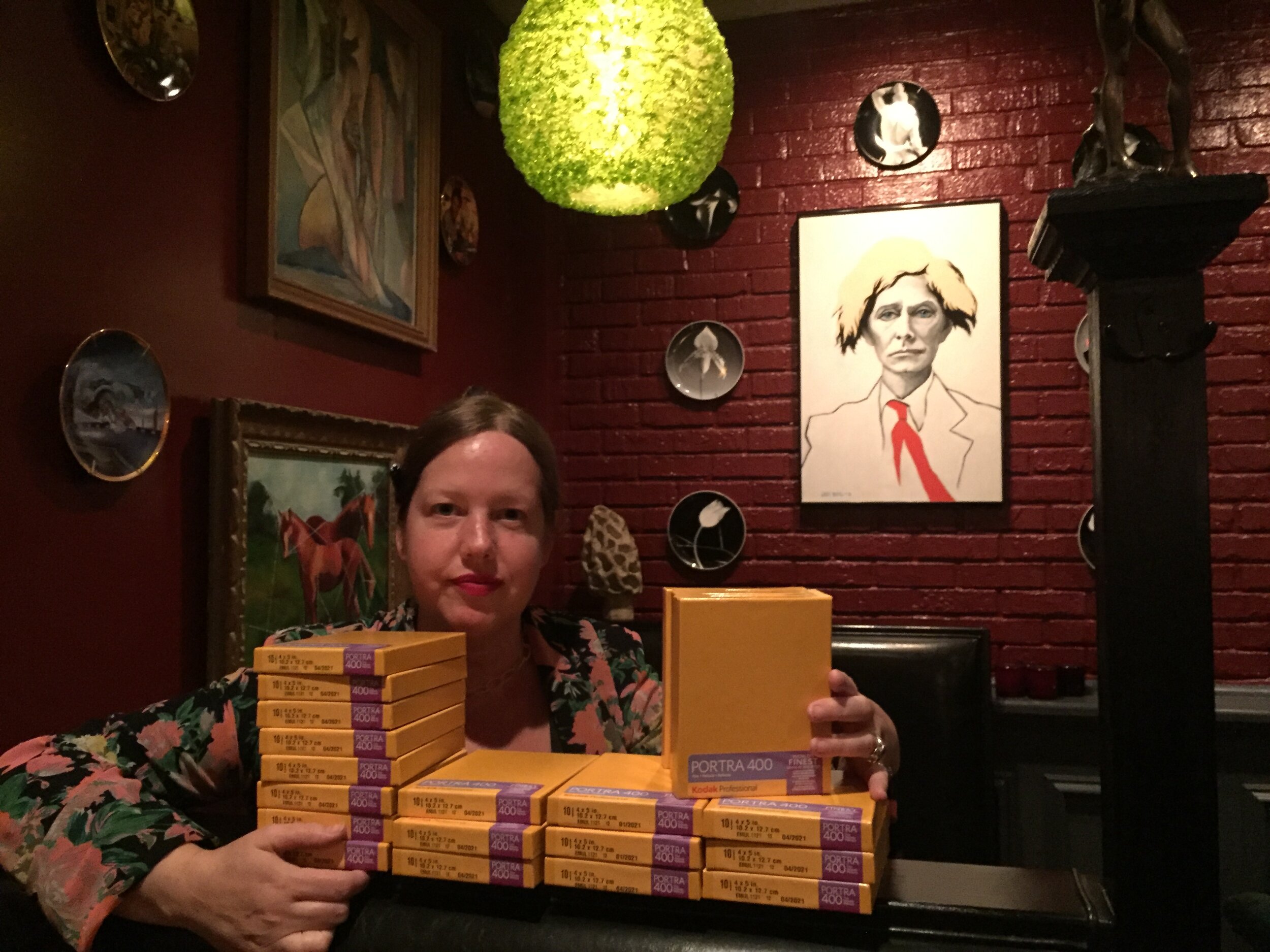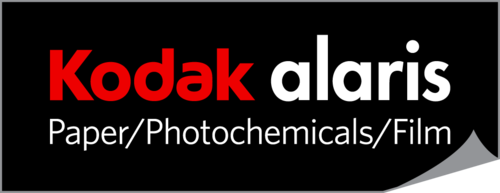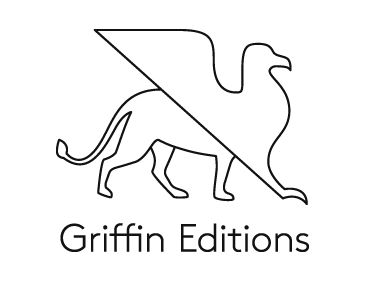Interview: Susan Worsham
Susan Worsham received the Film Photo Award in the Spring of 2019. One year later, Julia Bennett catches up with Susan.
What has it meant to receive this award, and to make this work with Kodak Professional Film?
Self-portrait with Kodak Film, Spring 2019
© Susan Worsham
My refrigerator full of film has been my sustenance this year.
For me this award meant that I had enough. I didn't have to spread myself thinly across all of the areas of my artistic practice.
I could make and develop new photographs as well as scan older negatives that are part of the same body of work.
Film is important to me. It is the material, and the process that I have used throughout my work to heal and to create something beautiful through loss.
It is amazing to me that the surface of film can capture all that I see in a moment and hold the weight of my story.
Simply put, film is magic.
Julia Bennett (JB): I’m so thrilled to be kicking off this conversation! I wanted to start by asking you why film is your medium of choice? How do you feel it informs this and other projects?
Susan Worsham (SW): If I had to distill my thoughts into one sentence, I would say this: Film is important to me.
It is the material, and the process that I have used throughout my work to heal and to create something beautiful through loss. But there is so much more...
There is this beautiful mystery with film–I see what is in the viewfinder, but film captures that moment with everything going on and slows it down and softens it. It quiets the moment as if the whole process of what the camera does is a cocoon and what emerges from the bath develops into something more poetic with more detail than my memory of it. Simply put, film is magic. It offers up these little surprises, these discoveries. It is amazing to me that the surface of film can capture all that I see in a moment and hold the weight of my story.
Girls and Horses, Southern Pines, North Carolina / © Susan Worsham
SW: I'll give you an example of a little surprise that a photograph gave me this year. I travelled to Southern Pines, North Carolina to photograph my friends three daughters at their grandmother’s house. They go every year and when I learned that they swim the horses in a pond to cool off during the day I really wanted to capture that scene. Their cousin Vivian visits at the same time and the girls spend a few weeks of their summers together. In both photographs that I have included here I noticed that the sisters are together on one side of the image and that Vivian is on the opposite side. There is not only a spatial distance, but Vivian is wearing a black bathing suit and leading a dark horse creating a distance in color as well. The portraits bring all of the girls together yet there is a separateness that mimics the distance that comes from being apart for the year, and also a familial distance. I did not see all of this when making the picture.
A photograph has a language that is only half understood when making the picture. It's as if someone wants to tell you something while you are looking through the lens, but you won't know exactly what that is until you spend time with the image. I would also say that film is not the only medium that I use. There are heavy ideas that I want to see in bronze and a fragility in some ideas that must be made of a breakable material such as porcelain or glass. But film has been with me on a constant basis the longest. It has within it the ability to hold a deeper dialogue than the surface of it.
Swimming Horses, Southern Pines, North Carolina / © Susan Worsham
Sisters, Southern Pines, North Carolina / © Susan Worsham
Vivian's New Horse / © Susan Worsham
JB: I love the idea that the film as a surface is included in the telling of your stories. That it adds something that perhaps you weren't anticipating or intending. I think anyone who shoots on film can relate to the magic of that process.
You talk in your proposal about this work being more about receiving rather than a project about being out in the world with your camera, open to whatever beauty you might find. I wonder if you could discuss that process more because some of your photographs seem so intentional. How do you stay open to serendipity when making images
Honeycomb Door / © Susan Worsham
SW: Yes, in my proposal I talk about the first few lines from my brother's suicide note…
“I arrived home just about the time the honeysuckle blooms.”
I talk about how my brother was not the sort of person to notice flowers, and how beautiful, achingly sad, and poetic it was for him to stop and see the beauty around him if only because he knew it would be for the last time. He was looking with a deliberateness, and I try to see that way, to notice the beauty around me, and pay attention to life's gifts, and not take them for granted. Quite often those gifts are photographs, but I have to be out in the world with my camera in order to receive them.
When I am out with my camera, I have different ways of seeing, both focused and open. Looking for specific things but being open to chance. It's why I don't like to think in terms of a project. It sets a boundary and I want to keep my process open, almost elastic so that it stretches with me and allows me to grow in different directions. I never want to pass by something that I am drawn to, and not take a photo because I think at the time that it doesn't fit into my project. For my By the Grace of God work I intentionally gave myself a title that would fit in between the two goalposts of life and death. So, I have a lot of room to work with.
As for serendipity, I believe you can plan for it by being open to it. A moment is only serendipitous if you see its value. If you see the thread that connects a chance event to a meaningful or lucky moment. I remember late summer when I was driving to Danville, Virginia to have lunch with Edith and Emmet Gowin. I really wanted to stop for a moment at this strange roadside diorama with faded decorations at the entrance to a deserted factory. I had been there earlier and discovered about fifteen or so Luna Moths scattered along the ground. Although stopping would make me late for lunch I couldn't help myself. The paper honeycomb decorations were still sadly and slowly spinning even though there had been several big storms. I looked around and didn't see any Luna Moths, but I did find several whole butterfly specimens. It was pretty magical. There must be some sort of bush there that attracts them or maybe the lights of the factory at night.
Edith and Emmet Gowin's Wedding Rings / © Susan Worsham
Emmet Gowin's Wedding Ring / © Susan Worsham
SW (continued): I remember calling from my phone while driving and trying to explain to Emmet through bad phone reception that I was going to be a little late because of the butterflies. Later after lunch I went out to my car to bring in my perfect pair of butterflies to show. Emmet left the room and came back with a nearly identical set and we stood there with our palms open holding and comparing our specimens. It was certainly not a moment that I could have foreseen, but I think a good example of serendipity. In regard to being open to serendipity. It is like following a path that is presented to you. I try to remain very open when making work, and often times I am out with my camera photographing something else when my subject appears. In Destiny, Grandmother's Roses, Va., I was photographing an abandoned swing set in an overgrown yard when Destiny and her brother came around the corner. I asked if they would take me to their mother and when she opened the door, I saw this beautiful sconce of golden roses high up on the wall. We ended up standing on a chair and taking the flowers down so that I could photograph Destiny holding her grandmother's roses.
Blue Legged Centipede in Peach Muffin Wrapper / © Susan Worsham
Tomato and Egg Delivery, Virginia / © Susan Worsham
Georgia with Firethorn / © Susan Worsham
Embalming Fluid and Shoe Box Graves / © Susan Worsham
JB: I think it's so beautiful for you to honor your brother by remaining open and perceptive to the world around you. There's also something to be said about your practice of inviting serendipity and creating space for your work to flex and change with time alongside the use of film, which itself can often surprise and delight with unanticipated shifts in color, light, and texture.
In speaking about your practice and the lightness that comes with perceiving moments around you as they come, remaining present, I find myself most drawn to your images of girls and young women. I have my own childhood memories of roaming the woods, playing games and capturing bugs. There is such a juiciness to that period, when time seems to move slow. Is there any element of surrogacy when you photograph your subjects? Does their role change between the time the photograph is made and when the image is situated in the broader scope of work?
SW: Yes, long before I explored with my camera in my car, I collected the neighbor's dog and went exploring on my Schwinn bicycle. It was indeed a ripe time, my legs covered in the blood of blackberries, mixed with the raised hills of mosquito bites. I pull from that time quite often because of its awkward beauty and freedom. There is so much going on emotionally at that time as well. I do see something of myself in all of the girls that I photograph, but mostly in my friend's daughter, Georgia, who I continue to watch grow through my lens. She represents youth, herself, and at the same time is a surrogate for me. I weave her into both bodies of work and her role can change depending on which series she inhabits.
My Best Friend's Daughter / © Susan Worsham
Georgia with Smoke Tree / © Susan Worsham
Georgia Outside of Ukrops Grocery / © Susan Worsham
Kate and Vivian / © Susan Worsham
SW (continued): And yes, a photograph's role can change. When the photograph is made, I only have an idea of it. When I look at the negative it starts to bring me back to that original idea, but it must be fleshed out in color or in tones of black and white before I can fully see it. Even then its meaning can change depending on what image is placed beside it. Images begin to speak to each other. The photograph of Destiny that I mentioned earlier can read many different ways. Depending on what I show beside the image of Destiny, her flowers can read as a funeral spray, or other times a corsage. The more photographs that you make, the more opportunities they have to speak to each other. The more photographs that you make, the more they begin to fit together like a large puzzle. But it's a puzzle that can be put together in many different ways.
Young Couple, Danville, Virginia / © Susan Worsham
Lifetime Knife Set / © Susan Worsham
JB: Okay, now for a few Rapid-Fire Questions… What’s your film-stock of choice and why?
SW: Kodak Portra 400, 4x5 film. I feel like it is the closest to natural color. Kodak T-Max 400,4x5 for black and white. I use it for its fine grain.
JB: Is there a photograph that you saw but never made that still haunts you?
SW: I'll give you one from this summer... Emmet Gowin walking to meet me at my car in his driveway in Danville Virginia. He had just come from his garden where he was picking tomatoes for our lunch. He had what looked like a black stain underneath the window of his finger. A bruise from hitting it accidentally with a hammer. The tomatoes in his hand were an unusual shape and color... green, yellow and black like a bruise but in the shape of large acorns. Oh, how I wanted a picture, but I thought it would be rude to jump out of my car and immediately ask for one.
JB: What do you hope for as you continue making this work?
SW: Inspiration.
Jared and the Neighbor's Son / © Susan Worsham
Miniature Graceland, Don Epperly's Front Yard, Virginia / © Susan Worsham
Jared, Oregon Hill Porch / © Susan Worsham





